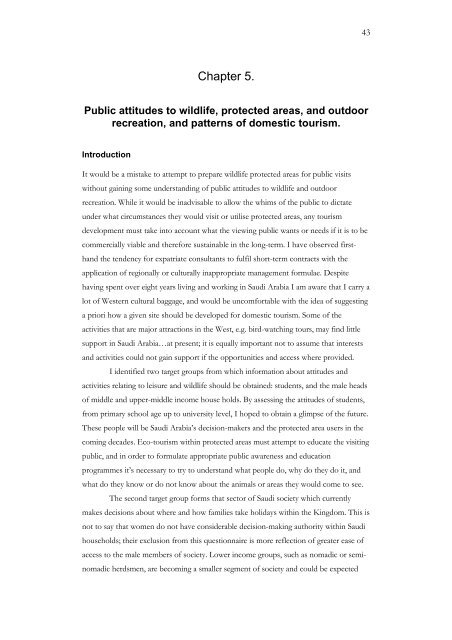The Unfenced Desert Towards a strategy for eco ... - Nwrc.gov.sa
The Unfenced Desert Towards a strategy for eco ... - Nwrc.gov.sa
The Unfenced Desert Towards a strategy for eco ... - Nwrc.gov.sa
Create successful ePaper yourself
Turn your PDF publications into a flip-book with our unique Google optimized e-Paper software.
Chapter 5.<br />
Public attitudes to wildlife, protected areas, and outdoor<br />
recreation, and patterns of domestic tourism.<br />
Introduction<br />
It would be a mistake to attempt to prepare wildlife protected areas <strong>for</strong> public visits<br />
without gaining some understanding of public attitudes to wildlife and outdoor<br />
recreation. While it would be inadvi<strong>sa</strong>ble to allow the whims of the public to dictate<br />
under what circumstances they would visit or utilise protected areas, any tourism<br />
development must take into account what the viewing public wants or needs if it is to be<br />
commercially viable and there<strong>for</strong>e sustainable in the long-term. I have observed firsthand<br />
the tendency <strong>for</strong> expatriate consultants to fulfil short-term contracts with the<br />
application of regionally or culturally inappropriate management <strong>for</strong>mulae. Despite<br />
having spent over eight years living and working in Saudi Arabia I am aware that I carry a<br />
lot of Western cultural baggage, and would be uncom<strong>for</strong>table with the idea of suggesting<br />
a priori how a given site should be developed <strong>for</strong> domestic tourism. Some of the<br />
activities that are major attractions in the West, e.g. bird-watching tours, may find little<br />
support in Saudi Arabia…at present; it is equally important not to assume that interests<br />
and activities could not gain support if the opportunities and access where provided.<br />
I identified two target groups from which in<strong>for</strong>mation about attitudes and<br />
activities relating to leisure and wildlife should be obtained: students, and the male heads<br />
of middle and upper-middle income house holds. By assessing the attitudes of students,<br />
from primary school age up to university level, I hoped to obtain a glimpse of the future.<br />
<strong>The</strong>se people will be Saudi Arabia’s decision-makers and the protected area users in the<br />
coming decades. Eco-tourism within protected areas must attempt to educate the visiting<br />
public, and in order to <strong>for</strong>mulate appropriate public awareness and education<br />
programmes it’s neces<strong>sa</strong>ry to try to understand what people do, why do they do it, and<br />
what do they know or do not know about the animals or areas they would come to see.<br />
<strong>The</strong> s<strong>eco</strong>nd target group <strong>for</strong>ms that sector of Saudi society which currently<br />
makes decisions about where and how families take holidays within the Kingdom. This is<br />
not to <strong>sa</strong>y that women do not have considerable decision-making authority within Saudi<br />
households; their exclusion from this questionnaire is more reflection of greater ease of<br />
access to the male members of society. Lower income groups, such as nomadic or seminomadic<br />
herdsmen, are b<strong>eco</strong>ming a smaller segment of society and could be expected<br />
43

















